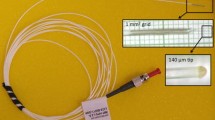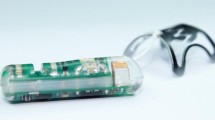Abstract
Sphincter of Oddi manometry is the “gold standard” to evaluate the ductal anatomy of patients with suspected sphincter of Oddi dysfunction. During such procedure it can be unclear which duct is being investigated without radiographs. Bilirubin and other pigments in bile strongly absorb blue light, whereas pancreatic fluid is clear and does not absorb blue light. The bio-sensor system incorporates fibre-optic technology to measure blue light absorbance in the ducts. Bench tests and animal tests were conducted utilising possums. In bench and animal experiments the bio-sensor correctly discriminated between bile and pancreatic juice, based on the absorbance of blue light. The mean absorbance of the bile was 3.57±1.74 and that of the pancreatic duct fluid was 0.53±0.34 (P<0.01) in the animal models. The optical sensing system could be incorporated into a manometry catheter to aid sphincter of Oddi manometry shortening procedure time and reduce radiography exposure.







Similar content being viewed by others
References
Al-Jiffry BO, Jobling JM, Schloithe AC, Toouli J, Saccone GT (2001) Secretin induces variable inhibition of motility in different parts of the Australian possum sphincter of Oddi. Neurogastroenterol Motil 13(5):449–445
Baldini F, Bechi P, Cianchi F, Falai A, Fiorillo C, Nassi P (2000) Analysis of the optical properties of bile. J Biomed Opt 5(3):321–329
Caldwell MTP, Byrne PJ, Brazil N, Crowley V, Attwood SEA, Walsh TN, Hennessy TPJ (1994) An ambulatory bile reflux monitoring system: an in vitro appraisal. Physiol Meas 15:57–65
Craig A, Toouli J (1999) Investigation of sphincter of Oddi dysfunction. HPB 1(1):21–24
Dodds WJ, Hogan WJ Geenen JE (1889) Motility of the biliary system. In: Schultz SG (ed) Handbook of physiology. The gastrointestinal system, 2nd edn. Waverly Press, Baltimore, pp 1055–1101
Konomi H, Woods CM, Meedeniya AC, Giles LC, Toouli J, Saccone GT (2001) Effects of diaspirin cross-linked hemoglobin on motor function of the duodenum and biliary system in the Australian brush-tailed possum in vivo. J Pharmacol Exp Ther 296(3):1067–1073
Maldonado ME, Brady PG, Mamel JJ, Robinson B (1999) Incidence of pancreatitis in patients undergoing sphincter of Oddi manometry (SOM). Am J Gastroenterol 94(2):387–390
Scicchitano J, Saccone GT, Baker RA, Roberts-Thomson IC, Toouli J (1995) How safe is endoscopic sphincter of Oddi manometry? J Gastroenterol Hepatol 10(3):334–336
Testoni PA (2003) Preventing post-ERCP pancreatitis: where are we? JOP 4(1):22–32
Toouli J, Craig A (1999) Clinical aspects of sphincter of Oddi function and dysfunction. Curr Gastroenterol Rep 1(2):116–122
Vaezi MF, Lacamera RG, Ritchter JE (1994) Validation studies of Bilitec 2000: an ambulatory duodenogastric reflux monitoring system. Am J Physiol 267(6):G1050–G1057
Acknowledgements
This research project was supported by Flinders University, Flinders Small Grants Scheme. We would like to acknowledge the assistance provided by the Department of Surgery, Pancreatobiliary Research Group at the Flinders University for their assistance in the animal experiments. In particular, we would like to thank Dr Yukio Sonoda, Mrs Charmaine Woods, Mr James London for all their time and support. We also thank Mrs A. C. Schloithe for assistance with the statistical analysis.
Author information
Authors and Affiliations
Corresponding author
Rights and permissions
About this article
Cite this article
Pallotta, O.J., Saccone, G.T.P. & Woolford, R.E. Bio-sensor system discriminating between the biliary and pancreatic ductal systems. Med Bio Eng Comput 44, 250–255 (2006). https://doi.org/10.1007/s11517-006-0035-3
Received:
Accepted:
Published:
Issue Date:
DOI: https://doi.org/10.1007/s11517-006-0035-3




